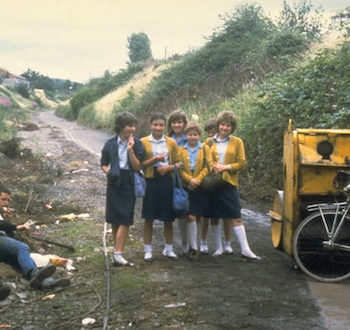The cyclist-dooring Transport Secretary Chris Grayling has revealed plans to return some former railway trackbeds into working lines. However, many of these trackbeds – closed due to the Beeching cuts of the 1960s – are now used as traffic-free trails, and Sustrans has warned that any line reopenings must maintain the existing trails.
The plans are part of a new rail strategy plan. Grayling said: “Many commuter services are full and getting busier and passengers know how much pressure the network is under … We need to expand our network to unlock jobs and housing growth across the country.” Connecting People: A strategic plan for rail does not include any mentions of traffic-free trails.
Grayling is not offering any cash to open the former railway lines although if any did open it would be ironic because the Beeching cuts came from a road-building-obsessed Tory Government. The Reshaping of British Railways was a now infamous 1963 report by Dr. Richard Beeching on Britain’s railway network, which resulted in its decimation. It was commissioned by Transport Secretary Ernest Marples. In 1960, Marples told delegates at the Tory party conference that “we have to rebuild our cities. We have to come to terms with the car.” (Marples was far from a disinterested party – he owned two-thirds of Marples, Ridgway, and Partners, a Westminster-based civil engineering firm that built roads.)
Following the publication of Dr. Beeching’s report the government of the day ripped out more than 5,000-miles of track from Britain’s historic and world-famous rail network. The steel rails may have been removed but the track beds remained and, in time, some of these rights-of-way were transformed into cycle trails. The UK’s current “National Cycle Network” – 14,000-miles of traffic-free and quiet routes administered by Sustrans, founded by a visionary called John Grimshaw – sprang from one fifteen-mile stretch of former railway line.
Grimshaw wasn’t the first to lobby for the cycle-conversion of Britain’s (not at all) Permanent Way. That distinction goes to Michael Dower, a conservationist who, in 1992, became director general of Britain’s Countryside Commission. In 1963, writing in Architectural Review, Dower proposed that the track beds left after the Beeching cuts should form a national system of “greenways,” and that it would be cyclists who would be the greatest beneficiaries of them. The idea lay fallow until a 1970 government report picked up on the suggestion. Written by J.H. Appleton for, as it happens, the Countryside Commission, Disused Railways in the Countryside of England and Wales suggested that the track beds might also be used as refuse dumps, shooting ranges, nature reserves, linear campsites, running tracks, and – in Cambridgeshire – as an access road to a radio telescope.
But cycle-trail use was one of the leading contenders, for Appleton said: “Increasing traffic has made conditions on many roads less attractive and less safe for cyclists, and the ability to move freely through the countryside . . . would open up greatly the possibilities . . .[for cycling].”
He admitted that “cycling is a declining activity” but said this was a decline that the “disused railways might be able to relieve.”
Appleton revealed that the Ramblers’ Association, the British Horse Society, and the Cyclists’ Touring Club were “pooling their interests” in order to “secure facilities which they would be unlikely to achieve for any one of them alone.” He explained that “this common interest of users” was motivated by “the desire for segregation from road traffic as an issue of safety.”
In July 1977, a group of Bristol-based environmental campaigners formed Cyclebag, a cycling advocacy group that would put these ideas into action. Cyclebag – an acronym for Conserve Your Calf and Leg Energy Bristol Action Group – would later transform into Sustrans. The group’s founders included civil engineer Grimshaw (who would become CEO of Sustrans and who would create the National Cycle Network concept); journalist Alistair Sawday (who would go on to create a travel-guide empire and sustainable-holiday company); cinematographer David Sproxton (co-creator of the Oscar Award-winning studio Aardman Animations, maker of Wallace and Gromit); and architect George Ferguson (who, in 2012, became the first elected mayor of Bristol).
“Cyclebag emerged as a constructive protest against the domination of the motor lobby in our politics and our roads,” stated Ferguson. In 1979, the campaign group – led by Grimshaw – leased a stretch of the former Midland Railway and, with volunteer labor (including Grimshaw’s own), created a five-mile cycling and walking trail between Bath and Bitton; it was later extended to became the station-to-station Bristol to Bath trail. This was not the first rail trail in the UK – the Manifold Railway Path in the Peak District of northern England was created in the 1930s – but it was the springboard from which Sustrans, founded in 1983, pushed for the formation of the ambitious National Cycle Network.
Quick look at Beeching report. 5-10k passengers a week in 1963, i.e. <500k pa. 2007 cycle path usage as 2.5m (according to WP). pic.twitter.com/04Bfcn4FOI
— Peter Miller (@PeterEastern) November 29, 2017
The Bristol to Bath trail may be popular but in 2008 local councils proposed grubbing it up and converting it into a bus-rapid-transport line. These plans were successfully fought off at the time but are regularly dusted down – Grayling’s floated idea will no doubt encourage those who wish to see the popular traffic-free trail turned back into a motorised route. Traffic-free usage of this particular trail is now five times greater than it was when the railway closed (there are now 2.5 million annual journeys along the trail by pedestrians and cyclists but there were fewer than rail passengers in 1963).
Sustrans CEO Xavier Brice said: "Whilst we welcome the potential re-opening of disused railway lines in principle, it will be critical that the many walking and cycling routes which have been built along some of these lines are also maintained.
“These routes, some of which form the National Cycle Network, are a critical part of the country’s active travel infrastructure and strategy, encouraging people to walk and cycle in a safe environment, as well as providing important commuting access for people choosing to travel actively to work.
“Every year an estimated five million people use the NCN. These trips save the UK economy over £550 million each year by reducing levels of obesity, of this £75 million is saved from the NHS budget.”
Sustrans is currently carrying out a review of the National Cycle Network with the support of national and local governments and other partners. By identifying where the NCN needs developing, realigning, and expanding, Sustrans will deliver a long-term Strategic Improvement Plan later in 2018 for the entire UK.
+++
Pix from Sustrans. The historical aspects of this article were informed by my book, Bike Boom.
 BikeBiz Bicycle and cycling retail news
BikeBiz Bicycle and cycling retail news




